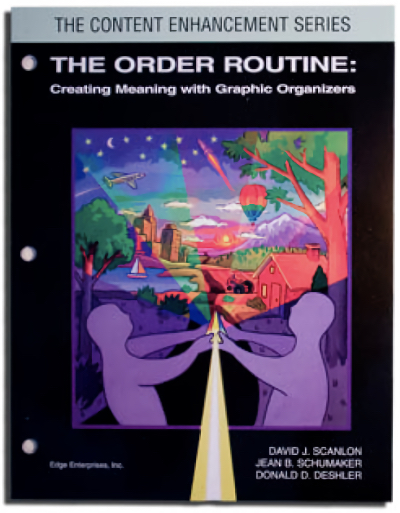The ORDER Routine

Teachers use the ORDER Routine to organize and make sense of information visually. Students think about what they have just learned or read, try to understand how it all fits together, look for any missing information or errors in their notes, and try to fit it all together to create their own graphic organizer.
Students with and without LD in grades 7 to 12 whose teachers taught them how to use the ORDER Routine had significantly higher test scores on recognizing the expository relationships among content in a reading passage and in creating appropriate graphic organizers for the content compared to when
SIM Mnemonic Learning Devices created for this strategy (2004):
- ORDER - to help students develop a graphic organizer
Author(s): David J. Scanlon, Jean B. Schumaker, and Donald D. Deshler
Publication & Purchasing Info: University of Kansas, Center for Research on Learning
KU CRL Online Store
Resources:
The Order Routine Research (pdf)
Research Articles:
- Bulgren. J., & Scanlon, D. (1997). Instructional routines and learning strategies that promote understanding of content area concepts. Journal of Adolescent & Adult Literacy, 41(4), 292-302. This article provides examples of using content enhancement routines (Concept Diagram, Comparison Table, ORDER) to promote an understanding of middle and secondary school content area concepts.
The Story Behind the ORDER Routine from author David Scanlon:
When I arrived at the KU-CRL, inclusion was a relatively new phenomenon, but Don Deshler and Jean Schumaker were already at the vanguard. They asked me to help them think about how to adapt SIM to this new context. I brought my interest in the literacy skills students need to be successful in the content areas to the table. We had general ideas of the challenge we wanted to address, but we wanted to seek the input of teachers to more fully understand the complexities of the situation. We decided initially to consult with social studies teachers, because that content area reflects a variety of the literacy skills students are typically called upon to perform across the school day. We also involved special educators and a few teachers from other content areas at the middle-school and high-school levels.
The first thing the teachers informed us about was the variety of academic skills needed for students to be successful in their courses. We gathered their information, and then we talked and studied for many hours on how to address their concerns. At the same time, we considered the applications of strategic instruction to their inclusive contexts. We knew that the task before us was not only to apply strategic instruction in fast-paced, academically diverse classes, sometimes with minimal direct special education support, but also to guide students in performing higher order thinking and learning skills.
After several experimental iterations, we arrived at the ORDER “Strategy,” a set of steps that students could follow to depict relationships among the information they were learning. A large number of middle-school and high-school teachers and their students collaborated with us as the teachers implemented the strategy instruction in their classrooms and gave us feedback. There were a few teachers who stuck with us through multiple years of research. They all provided great practical insights about how the ORDER Strategy could be used by students to fit the demands of the context. In fact, we came to realize that the ORDER Strategy needed to become the ORDER Routine, based on feedback from teachers about how they needed to support students in learning such a higher order process while also attending to the many demands on them to “get through” the curriculum with a diverse student population. We are very proud of the fact that the ORDER Routine provides students with procedures to facilitate their critical reflection on lessons or readings, which includes recognizing the relationships required for comprehending content and explaining what they know.
Author's Thoughts About The ORDER Routine:
While I have already confessed to being a fan of strategic instruction, I take particular pride in the ORDER Routine. I think we developed something really special. This routine helps students with LD, other struggling learners, and their peers to think critically, instead of simply getting “the right answer.” Students who learn to use ORDER Steps are really learning to think. Another great thing about the routine is that it facilitates students’ performance of skills that good learners use. The routine is not a convoluted procedure, and it does not reduce the content to isolated bits of basic information. With this routine, students are actively engaged in thinking about what they are learning.
Teacher and Student Feedback on the ORDER Routine:
Nearly twenty years after we began the research that resulted in the ORDER Routine, I still exchange holiday letters with one of the teachers who helped us from the start. Almost every year, she writes about how our project “saved her” or was “the first thing” that really helped her to engage her students. She, too, knew that real learning required engaged thinking, not just regurgitation. Many of the teachers who have learned to use the routine have given us similar feedback. They find that they can use it with students of varied ability levels and that it makes a difference in how thoroughly their students comprehend lesson or reading content. Perhaps the best feedback of all is watching students as they learn the routine; over time, their ability to explain their knowledge in rich and expansive ways improves dramatically!
This manual is available through the KU CRL Shop.
Please note that professional development, coaching, and infrastructure support are essential components to effective implementation of SIM instructional tools and interventions. It is highly recommended that you work with a SIM professional developer. See the SIM Event list for sessions or email simpd@ku.edu to learn more.
An accessible version of the documents on this site will be made available upon request. Please contact the KU CRL Professional Development Research Institute, at simpd@ku.edu to request the document be made available in an accessible format.